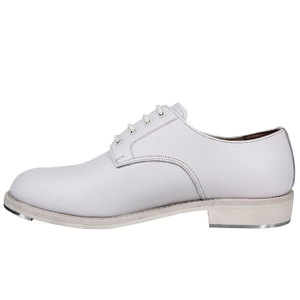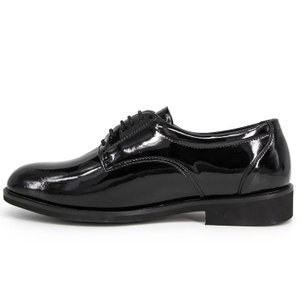Oxford shoes have become a timeless symbol of elegance and sophistication in footwear. These classic dress shoes originated in the 19th century at Oxford University in England, where students sought a more comfortable alternative to the high-top boots of the era. The distinctive feature that sets Oxford shoes apart is their closed lacing system, which gives them a sleek and formal appearance.
Over the years, Oxford shoes have evolved from their academic roots to become a staple in both formal and casual wardrobes. They are prized for their versatility, suitable for a wide range of occasions from black-tie events to business meetings and even some casual settings. The enduring popularity of Oxford shoes stems from their clean lines, refined silhouette, and the air of professionalism they lend to any outfit.
The Anatomy of an Oxford Shoe
A. Closed lacing system
The hallmark of an Oxford shoe is its closed lacing system. This design feature is characterized by the eyelet tabs being stitched under the vamp, creating a clean and uninterrupted look across the top of the shoe. The closed lacing system results in a narrower fit and a more formal appearance compared to other dress shoe styles.
B. Vamp and quarters
The vamp refers to the front part of the shoe that covers the toes and instep. In Oxford shoes, the vamp is typically a single piece of leather, contributing to the shoe's sleek profile. The quarters, which form the sides and back of the shoe, are sewn on top of the vamp. This construction allows for a snug fit and helps maintain the shoe's shape over time.
C. Comparison with Derby shoes
While Oxford and Derby shoes may appear similar at first glance, the key difference lies in their lacing systems. Unlike Oxfords, Derby shoes feature an open lacing system where the eyelet tabs are sewn on top of the vamp. This distinction gives Derby shoes a slightly more casual look and a roomier fit, making them a popular choice for those who prefer a more relaxed style or require additional foot space.
The Rich History of Oxford Shoes
A. Origins at Oxford University
The story of Oxford shoes begins in the hallowed halls of Oxford University during the 1800s. Students at this prestigious institution sought a more comfortable alternative to the high-top boots that were fashionable at the time. The result was a lower-cut shoe that allowed for greater freedom of movement and comfort during long hours of study and socializing.
B. Evolution from Oxonian boots
The Oxford shoe evolved from the Oxonian boot, a half-boot style popular among Oxford students. Over time, the boot was modified, lowering the height and introducing the closed lacing system that would become the defining feature of Oxford shoes. This transformation marked a significant shift in men's footwear fashion, moving towards more practical and versatile styles.
C. Global popularity and adoption
As Oxford graduates entered the professional world, they brought their preferred footwear with them. The style quickly gained popularity among the upper classes and professionals, spreading beyond the university and across England. By the early 20th century, Oxford shoes had become a staple of men's formal wear worldwide, appreciated for their elegance and versatility.
Types of Oxford Shoes
A. Plain-toe Oxfords
Plain-toe Oxfords are the most minimalist and formal version of the Oxford shoe. They feature a smooth, unadorned toe cap, making them ideal for black-tie events and formal business settings. The clean lines of plain-toe Oxfords emphasize the shoe's elegant silhouette and are often preferred for their timeless simplicity.
B. Cap-toe Oxfords
Cap-toe Oxfords feature a separate piece of leather sewn across the toe, creating a "cap" effect. This style strikes a balance between formal and slightly more casual, making it versatile for both business and dressy occasions. Cap-toe Oxfords are popular among professionals who desire a touch of visual interest without compromising on formality.
C. Wholecut Oxfords
Wholecut Oxfords are crafted from a single piece of leather, resulting in a sleek and seamless appearance. This construction method requires exceptional skill and high-quality leather, making wholecut Oxfords a premium choice. Their understated elegance makes them suitable for formal events and sophisticated business settings.
D. Wingtip Oxfords
Wingtip Oxfords, also known as brogues, feature decorative perforations and a pointed toe cap that extends along both sides of the shoe, resembling a bird's wing. This style adds visual interest and a touch of flair to the classic Oxford design. Wingtip Oxfords can range from semi-formal to casual, depending on the extent of the broguing and the color of the shoe.
E. Brogue Oxfords
Brogue Oxfords are characterized by decorative perforations, or "broguing," along the edges of the shoe's visible leather pieces. Originally designed as a functional feature to allow water drainage in wet conditions, broguing has become a stylish embellishment. Brogue Oxfords come in various styles, from quarter brogues with minimal perforations to full brogues with extensive decorative patterns.
Materials and Craftsmanship
A. Traditional leather construction
Oxford shoes are renowned for their exquisite leather construction. Premium calfskin is often the material of choice, prized for its durability, flexibility, and ability to develop a rich patina over time. The leather upper is typically paired with a sturdy leather sole, creating a harmonious blend of elegance and longevity. This traditional construction method ensures that Oxford shoes maintain their shape and comfort throughout years of wear.
B. Alternative materials (suede, canvas)
While leather remains the classic choice, modern Oxford shoes embrace a variety of materials to cater to diverse tastes and occasions. Suede Oxfords offer a softer, more casual appearance while retaining the shoe's iconic silhouette. These are popular for less formal settings and pair well with both business casual and smart casual outfits. Canvas Oxfords provide a lightweight, breathable option ideal for warmer climates or relaxed environments. These alternative materials expand the versatility of Oxford shoes, making them suitable for a wider range of occasions and personal styles.
C. Importance of quality in Oxford shoes
The quality of materials and craftsmanship is paramount in Oxford shoes. High-grade leather, precise stitching, and expert construction techniques contribute to the shoe's longevity and comfort. Quality Oxford shoes often feature Goodyear welting, a method that allows for easy resoling and extends the life of the shoe. Attention to detail in the finishing touches, such as the lining and insole, ensures a superior wearing experience. Investing in well-crafted Oxford shoes not only enhances one's style but also provides long-term value through durability and comfort.
Care and Maintenance of Oxford Shoes
A. Cleaning and polishing techniques
Proper care is essential to maintain the appearance and longevity of Oxford shoes. Regular cleaning with a soft brush removes dirt and debris. For leather Oxfords, applying a quality shoe cream or polish not only enhances the shine but also nourishes the leather, preventing cracks and maintaining suppleness. Suede Oxfords require gentle brushing with a specialized suede brush to restore the nap. It's crucial to allow shoes to dry naturally if they become wet, avoiding direct heat sources that can damage the leather.
B. Storage recommendations
Correct storage plays a vital role in preserving Oxford shoes. Using cedar shoe trees helps absorb moisture and maintain the shoe's shape when not in use. Storing Oxfords in a cool, dry place away from direct sunlight prevents leather discoloration and cracking. For those with multiple pairs, rotating wear allows each pair to rest and air out between uses, extending their lifespan. Dust bags or shoe boxes provide additional protection during storage, keeping the shoes clean and ready for their next outing.
C. Resoling and repair
Despite their durability, Oxford shoes may eventually require resoling or repair. Goodyear-welted Oxfords are particularly amenable to resoling, allowing for multiple sole replacements without compromising the upper's integrity. Professional cobblers can replace worn soles, repair damaged stitching, or address other wear-related issues. Regular maintenance checks can identify potential problems early, ensuring timely repairs that extend the life of these classic shoes.
Oxford shoes stand as a testament to timeless style and craftsmanship. Their versatility spans from formal occasions to casual settings, adapting to modern fashion while retaining their classic appeal. Whether crafted from traditional leather or contemporary materials, Oxford shoes continue to be a staple in both men's and women's wardrobes. The enduring popularity of styles like brown Oxford shoes and the practical adaptations seen in Oxford boots for military use underscore the shoe's versatility and enduring relevance. With proper care and maintenance, a quality pair of Oxford shoes becomes not just a fashion statement, but a long-term investment in style and comfort.
For those seeking the perfect blend of style, durability, and functionality in their footwear, look no further than Milforce. Since 1984, Milforce has been a leading supplier of premium quality military boots, serving customers across Europe, North America, and Russia. Their extensive range includes army boots, combat boots, desert boots, tactical boots, and police boots, all crafted with advanced manufacturing processes and innovative designs. Whether you're in need of robust Oxford boots for military use or seeking a reliable, high-quality footwear option, Milforce offers competitive pricing, timely delivery, and exceptional customer service. Explore Milforce's collection today and step into comfort, style, and unparalleled durability.





















